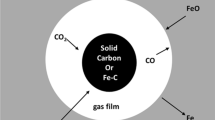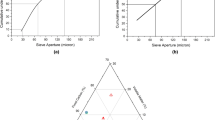Abstract
The reaction kinetics, activation energy, and reduction rates of different carbon reductant properties with electric arc furnace (EAF) slag determine the effectiveness of carbon in EAF steelmaking. This article investigates the interaction between slag and carbonaceous materials derived from palm char and coke. Palm shells were converted into palm char using chemical activation method (phosphorus acid, H3PO4) and pyrolyzed at 450 °C for 2 h in a horizontal tube furnace. Then, all the carbonaceous materials were mixed with iron oxide from slag with mass ratio of 1:3.73. The reduction reaction was carried out in a horizontal tube furnace at different temperature ranges of 1250–1550 °C under argon gas to understand the reaction kinetics, activation energies, and reduction rates of iron oxide from EAF slag with palm char and coke. All iron oxides in EAF slag were completely reduced into metallic iron at 1550 °C for both reductants. The phase and quantity of reduced iron were confirmed by Rietveld refinement method using X-ray diffraction (XRD) pattern and energy-dispersive X-ray spectroscopy (EDX). Palm char/slag has lower activation energy value, E (38.52 kJ/mol), than coke/slag (47.75 kJ/mol). The reaction rate of palm char was found faster (4.99 × 10–5 mol/cm2 s) than coke due to larger specific surface area, higher pore volume, amorphous carbon structure, and higher fixed carbon with high volatile content leading to lower activation energy, thus accelerating the iron oxide reduction rates. This finding forms the basic understanding of the reaction between EAF slag and carbonaceous materials for future research on the production of palm char as a feasible carbon reductant in EAF steelmaking.
Graphical Abstract









Similar content being viewed by others
References
Weldegiorgis FS, Franks DM (2014) Social dimensions of energy supply alternatives in steelmaking: comparison of biomass and coal production scenarios in Australia. J Clean Prod. https://doi.org/10.1016/j.jclepro.2013.09.056
Sohn HY, Mohassab Y (2016) Development of a novel flash ironmaking technology with greatly reduced energy consumption and CO2 emissions. J Sustain Metall. https://doi.org/10.1007/s40831-016-0054-8
Wang Z, Sohn I (2019) A review on reclamation and reutilization of ironmaking and steelmaking slags. J Sustain Metall. https://doi.org/10.1007/s40831-018-0201-5
Cavaliere P, Cavaliere P (2019) Clean ironmaking and steelmaking processes: efficient technologies for greenhouse emissions abatement. In: Clean ironmaking and steelmaking processes. https://doi.org/10.1007/978-3-030-21209-4_1
Mandova H, Leduc S, Wang C et al (2018) Possibilities for CO2 emission reduction using biomass in European integrated steel plants. Biomass Bioenergy. https://doi.org/10.1016/j.biombioe.2018.04.021
Wang C, Mellin P, Lövgren J et al (2015) Biomass as blast furnace injectant—considering availability, pretreatment and deployment in the Swedish steel industry. Energy Convers Manag. https://doi.org/10.1016/j.enconman.2015.04.013
Abd Rashid RZ, Salleh HM, Ani MH et al (2014) Reduction of low grade iron ore pellet using palm kernel shell. Renew Energy. https://doi.org/10.1016/j.renene.2013.09.046
Ahmed H (2018) New trends in the application of carbon-bearing materials in blast furnace iron-making. Minerals 8:561. https://doi.org/10.3390/min8120561
Gorantiwar VS, Shrivastava RL (2015) Validating quality productivity improvement framework for sponge iron industry in India. Prod Manuf Res. https://doi.org/10.1080/21693277.2015.1012233
Yunos NFM, Aziz NA, Ismail AN, Idris MA (2015) Reduction behaviour of iron ores by agricultural waste chars. Mater Sci Forum. https://doi.org/10.4028/www.scientific.net/MSF.819.31
Yunos NFM, Zaharia M, Idris MA et al (2012) Recycling agricultural waste from palm shells during electric arc furnace steelmaking. Energy Fuels. https://doi.org/10.1021/ef201184h
Najmi NH, Yunos NFM, Othman NK, Idris MA (2019) The correlation between structural and reduction kinetics of carbon from agricultural waste with hematite. J Mater Res Technol. https://doi.org/10.1016/j.jmrt.2018.11.014
Zaharia M, Yunos NF, Sahajwalla V (2013) Recycled and renewable materials as resources for electric arc furnace steelmaking. In: From materials to structures: advancement through innovation—Proceedings of the 22nd Australasian Conference on the Mechanics of structures and materials, ACMSM 2012
Ismail AN, Yunos NFM, Jamaludin SB et al (2017) Influence of reduction temperatures on reduction of FeO-containing slag by agricultural waste. Mater Sci Forum. https://doi.org/10.4028/www.scientific.net/MSF.888.441
Syarien S (2018) Metallurgical coke—back to charcoal. http://www.supremecarbon.com/metalbriq.htm. Accessed 8 Jan 2020
Nur NF, Najmi NH, Munusamy SRR, Idris MA (2019) Effect of high temperature on reduction-controlling reaction rate of agricultural waste chars and coke with steelmaking slag. J Therm Anal Calorim. https://doi.org/10.1007/s10973-019-08221-9
Teasdale SL, Hayes PC (2005) Observations of the reduction of FeO from slag by graphite, coke and coal char. ISIJ Int. https://doi.org/10.2355/isijinternational.45.634
Ueda S, Watanabe K, Yanagiya K et al (2009) Improvement of reactivity of carbon iron ore composite with biomass char for blast furnace. ISIJ Int. https://doi.org/10.2355/isijinternational.49.1505
Khanna R, Li K, Wang Z et al (2019) Biochars in iron and steel industries. In: Char and carbon materials derived from biomass: production, characterization and applications. https://doi.org/10.1016/B978-0-12-814893-8.00011-0
Fidalgo B, Berrueco C, Millan M (2015) Chars from agricultural wastes as greener fuels for electric arc furnaces. J Anal Appl Pyrolysis. https://doi.org/10.1016/j.jaap.2015.01.027
Toloue Farrokh N, Suopajärvi H, Mattila O et al (2020) Characteristics of wood-based biochars for pulverized coal injection. Fuel. https://doi.org/10.1016/j.fuel.2020.117017
Man Y, Feng JX, Li FJ et al (2014) Influence of temperature and time on reduction behavior in iron ore–coal composite pellets. Powder Technol. https://doi.org/10.1016/j.powtec.2014.02.039
Ding YG, Wang JS, She XF et al (2013) Reduction characteristics and kinetics of bayanobo complex iron ore carbon bearing pellets. J Iron Steel Res Int. https://doi.org/10.1016/S1006-706X(13)60093-X
Park JO, Jung SM (2015) Effect of slag composition on reaction kinetics of carbon composite agglomerate in the temperature range of 1273 K to 1573 K (1000 °C to 1300 °C). Metall Mater Trans B. https://doi.org/10.1007/s11663-015-0296-z
Divakar M, Görnerup M, Lahiri AK (2001) Reduction of Iron oxide by carbon in stainless steelmaking slags. High Temp Mater Process. https://doi.org/10.1515/HTMP.2001.20.5-6.393
Benavidez E, Santini L, Martín A, Brandaleze E (2018) Influence of coke and graphite on the decomposition and melting behavior of a mold flux. J Mater Sci Eng B. https://doi.org/10.17265/2161-6221/2018.1-2.001
Ahmed HM, Viswanathan N, Bjorkman B (2014) Composite pellets—a potential raw material for iron-making. Steel Res Int. https://doi.org/10.1002/srin.201300072
Sun S, Lu WK (1999) Theoretical investigation of kinetics and mechanisms of iron ore reduction in an ore/coal composite. ISIJ Int. https://doi.org/10.2355/isijinternational.39.123
Huang XA, Ng KW, Giroux L, Duchesne M (2019) Carbonaceous material properties and their interactions with slag during electric arc furnace steelmaking. Metall Mater Trans B. https://doi.org/10.1007/s11663-019-01569-1
Khanna R, Spink J, Sahajwalla V (2007) Role of ash impurities in the depletion of carbon from alumina–graphite mixtures in to liquid iron. ISIJ Int. https://doi.org/10.2355/isijinternational.47.282
Wu Y, Matsuura H, Yuan Z, Tsukihashi F (2016) Equilibrium between carbon and FeO-containing slag in CO–CO2–H2O atmosphere by FactSage calculation. Steel Res Int. https://doi.org/10.1002/srin.201500482
Jouhari AK, Galgali RK, Datta P et al (2000) Foaming during reduction of iron oxide in molten slag. Iron Steelmak 27:27–31. https://doi.org/10.1179/030192300677345
Zaharia M, Sahajwalla V, Khanna R et al (2009) Carbon/slag interactions between coke/rubber blends and EAF slag at 1550°C. ISIJ Int. https://doi.org/10.2355/isijinternational.49.1513
Sahajwalla V, Zaharia M, Mansuri I et al (2013) The power of steelmaking—harnessing high temperature reactions to transform waste into raw material resources. Iron Steel Technol 10:68–83
Watanabe K, Ueda S, Inoue R, Ariyama T (2010) Enhancement of reactivity of carbon iron ore composite using redox reaction of iron oxide powder. ISIJ Int. https://doi.org/10.2355/isijinternational.50.524
Shen Z, Liang Q, Xu J et al (2015) In-situ experimental study of CO2 gasification of char particles on molten slag surface. Fuel. https://doi.org/10.1016/j.fuel.2015.08.010
Hernndez-Montoya V, Garca-Servin J, Ivn J (2012) Thermal treatments and activation procedures used in the preparation of activated carbons. In: Lignocellulosic precursors used in the synthesis of activated carbon—characterization techniques and applications in the wastewater treatment. https://doi.org/10.5772/39365
Ismail AN, Yunos NFM, Jamaludin SB, Asri Idris M (2015) Influence of recycled wastes on slag foaming during EAF steelmaking. Mater Sci Forum. https://doi.org/10.4028/www.scientific.net/MSF.819.381
Rietveld HM (2014) The Rietveld method. Physica Scr. https://doi.org/10.1088/0031-8949/89/9/098002
Hellenbrandt M (2004) The inorganic crystal structure database (ICSD)—present and future. Crystallogr Rev 10:17–22. https://doi.org/10.1080/08893110410001664882
Weidler PG, Luster J, Schneider J et al (1998) The Rietveld method applied to the quantitative mineralogical and chemical analysis of a ferralitic soil. Eur J Soil Sci. https://doi.org/10.1046/j.1365-2389.1998.00138.x
Uvarov V, Popov I (2013) Metrological characterization of X-ray diffraction methods at different acquisition geometries for determination of crystallite size in nano-scale materials. Mater Charact. https://doi.org/10.1016/j.matchar.2013.09.002
El-Tawil AA, Ahmed HM, Ökvist LS, Björkman B (2020) Self-reduction behavior of bio-coal containing iron ore composites. Metals (Basel). https://doi.org/10.3390/met10010133
Li Y, Zhang X, Yang R et al (2015) The role of H3PO4 in the preparation of activated carbon from NaOH-treated rice husk residue. RSC Adv. https://doi.org/10.1039/c5ra04634c
Manocha SM (2003) Porous carbons. Sadhana Acad Proc Eng Sci. https://doi.org/10.1007/BF02717142
Ismail AN, Yunos NM, Jamaludin SB et al (2016) Reduction of FeO in EAF steelmaking slag with palm shells under different activation methods. ARPN J Eng Appl Sci 11:9776–9782
Lutterotti L, Pillière H, Fontugne C et al (2019) Full-profile search–match by the Rietveld method. J Appl Crystallogr. https://doi.org/10.1107/S160057671900342X
Lu L, Sahajwalla V, Kong C, Harris D (2001) Quantitative X-ray diffraction analysis and its application to various coals. Carbon NY. https://doi.org/10.1016/S0008-6223(00)00318-3
Dankwah JR, Koshy P, Saha-Chaudhury NM et al (2011) Reduction of FeO in EAF steelmaking slag by metallurgical coke and waste plastics blends. ISIJ Int. https://doi.org/10.2355/isijinternational.51.498
Toshev BV (2017) Activation energy. Chemistry (Easton). https://doi.org/10.1007/978-3-662-44185-5_25
Suopajärvi H, Kemppainen A, Haapakangas J, Fabritius T (2017) Extensive review of the opportunities to use biomass-based fuels in iron and steelmaking processes. J Clean Prod. https://doi.org/10.1016/j.jclepro.2017.02.029
Gupta S, Ye Z, Kim BC et al (2014) Mineralogy and reactivity of cokes in a working blast furnace. Fuel Process Technol. https://doi.org/10.1016/j.fuproc.2013.02.009
Hong L, Sahajwalla V (2016) Reaction between steel-making slag and carbonaceous materials while mixing with high density polyethylene. High Temp Mater Process. https://doi.org/10.1515/htmp-2014-0122
Ter Teo P, Seman AA, Basu P, Sharif NM (2016) Characterization of EAF steel slag waste: the potential green resource for ceramic tile production. Procedia Chem. https://doi.org/10.1016/j.proche.2016.03.111
Lu L, Kong C, Sahajwalla V, Harris D (2002) Char structural ordering during pyrolysis and combustion and its influence on char reactivity. Fuel. https://doi.org/10.1016/S0016-2361(02)00035-2
Wu S, Gu J, Zhang X et al (2008) Variation of carbon crystalline structures and CO2 gasification reactivity of Shenfu coal chars at elevated temperatures. Energy Fuels. https://doi.org/10.1021/ef700371r
Mohd Yunos NF, Zaharia M, Ahmad KR et al (2011) Structural transformation of agricultural waste/coke blends and their implications during high temperature processes. ISIJ Int. https://doi.org/10.2355/isijinternational.51.1185
El-Geassy AA, Halim KSA, Bahgat M et al (2013) Carbothermic reduction of Fe2O3/C compacts: comparative approach to kinetics and mechanism. Ironmak Steelmak. https://doi.org/10.1179/1743281212Y.0000000076
Muwanguzi AJB, Karasev AV, Byaruhanga JK, Jönsson PG (2012) Characterisation of the physical and metallurgical properties of natural iron ore for iron production. ISRN Mater Sci. https://doi.org/10.5402/2012/147420
Guo PM, Zhao P, Kong LB, Wang L (2018) New. Calculation method for intrinsic rate constant of Boudouard reaction. J Iron Steel Res. https://doi.org/10.13228/j.boyuan.issn1001-0963.20170434
Sarma B, Cramb AW, Fruehan RJ (1996) Reduction of FeO in smelting slags by solid carbon: experimental results. Metall Mater Trans B. https://doi.org/10.1007/BF02915600
Rahman M, Khanna R, Sahajwalla V, O’Kane P (2009) The influence of ash impurities on interfacial reactions between carbonaceous materials and EAF slag at 1550°C. ISIJ Int. https://doi.org/10.2355/isijinternational.49.329
Richardson FD (1974) Physical chemistry of melts in metallurgy. Academic Press (Elsevier), New York
Maroufi S, Mayyas M, Mansuri I et al (2017) Study of reaction between slag and carbonaceous materials. Metall Mater Trans B. https://doi.org/10.1007/s11663-017-1020-y
Safarian J, Tangstad M (2010) Slag-carbon reactivity. In: 12th International Ferroalloy Congress. Sustainable future, pp 327–338
Acknowledgements
The author would like to acknowledge the support from the Fundamental Research Grant Scheme (FRGS) under Grant Number of FRGS/1/2020/TK0/UNIMAP/02/30 and FRGS/1/2013/SG06/UNIMAP/0214 from the Ministry of Higher Education Malaysia. The authors also acknowledge the financial support from Mentorship Research Grants under Research Management and Innovation Center (RMIC), and Faculty of Chemical Engineering Technology, Universiti Malaysia Perlis, (UniMAP) for this research.
Author information
Authors and Affiliations
Corresponding author
Ethics declarations
Conflict of interest
The authors declare that they have no known competing financial interests or personal relationships that could have appeared to influence the work reported in this paper.
Additional information
The contributing editor for this article was Il Sohn.
Publisher's Note
Springer Nature remains neutral with regard to jurisdictional claims in published maps and institutional affiliations.
Rights and permissions
About this article
Cite this article
Yunos, N.F.M., Ismail, A.N., Munusamy, S.R.R. et al. Reaction Kinetics of Palm Char and Coke with Iron Oxides in EAF Steelmaking Slag. J. Sustain. Metall. 7, 412–426 (2021). https://doi.org/10.1007/s40831-021-00342-6
Received:
Accepted:
Published:
Issue Date:
DOI: https://doi.org/10.1007/s40831-021-00342-6




